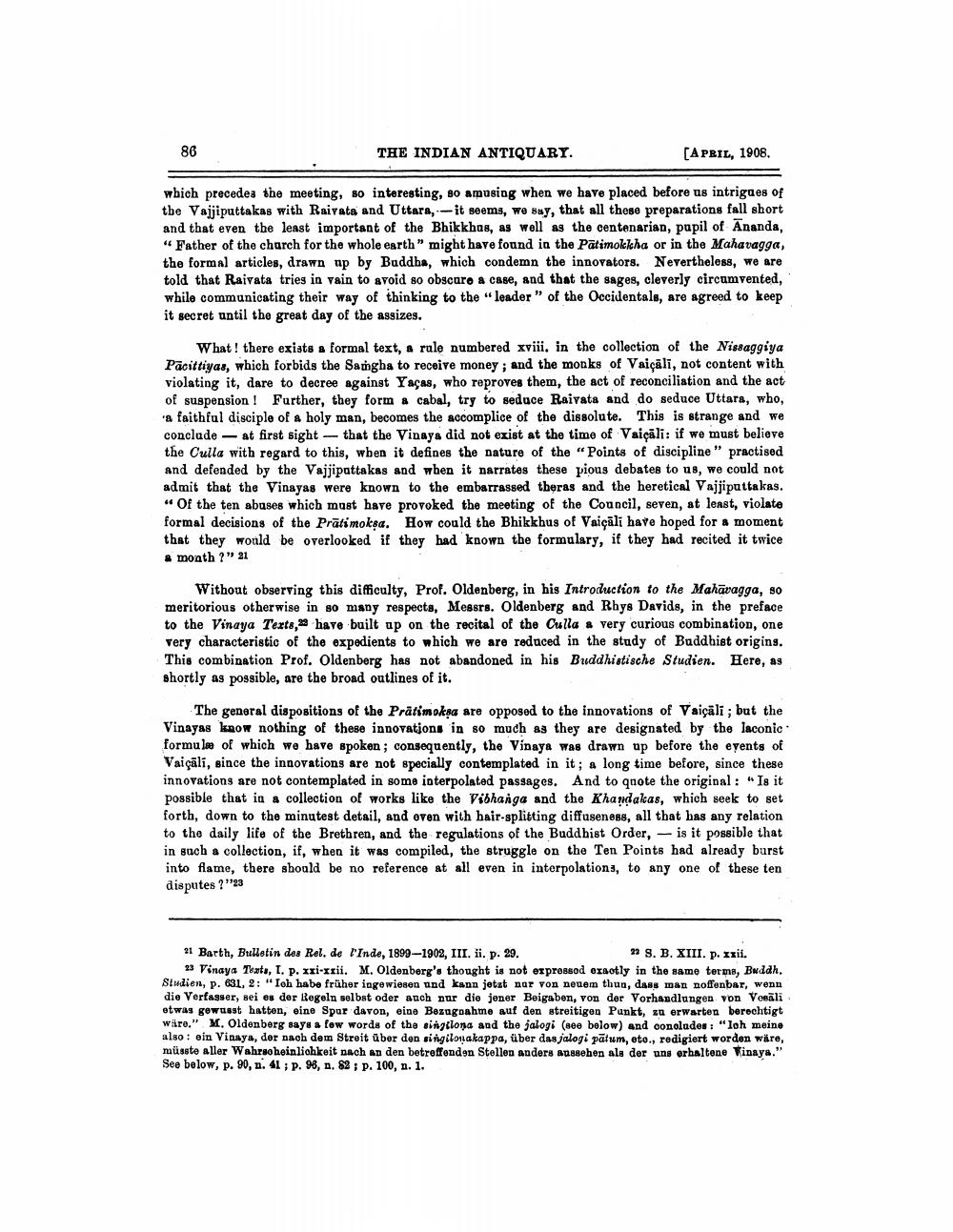________________
86
THE INDIAN ANTIQUARY.
[APRIL, 1908
which precedea the meeting, so interesting, so amusing when we have placed before us intrigues of the Vaijiputtakas with Raivata and Uttara,- it seems, we say, that all those preparations fall short and that even the least important of the Bhikkhas, as well as the centenarian, pupil of Ananda, "Father of the charch for the whole earth" might have found in the Patimoksha or in the Mahavagga, the formal articles, drawn up by Buddha, which condemn the innovators. Nevertheless, we are told that Raivata tries in vain to avoid so obscare a case, and that the sages, cleverly circumvented, while communicating their way of thinking to the leader of the Occidentals, are agreed to keep it secret until the great day of the assizes.
What! there exists a formal text, a rule numbered xviii, in the collection of the Nissaggiya Pacittiyas, which forbids the Samgha to receive money; and the monks of Vaicālī, not content with violating it, dare to decree against Yaças, who reproves them, the act of reconciliation and the act of suspension ! Further, they form a cabal, try to seduce Raivata and do seduce Uttara, who, a faithful disciple of a holy man, becomes the accomplice of the dissolute. This is strange and we conclude at first sight that the Vinaya did not exist at the time of Vaicāli: if we must believe the Culla with regard to this, when it defines the nature of the "Points of discipline" practised and defended by the Vajjipattakas and when it narrates these pious debates to us, we could not admit that the Vinayas were known to the embarrassed theras and the heretical Vajjiputtakas. “Of the ten abuses which must have provoked the meeting of the Council, seven, at least, violate formal decisions of the Prāti moksa. How could the Bhikkhus of Vaicāli have hoped for a moment that they would be overlooked if they had known the formulary, if they had recited it twice # mouth ?" 21
Without observing this difficulty, Prof. Oldenberg, in his Introduction to the Mahāvagga, so meritorious otherwise in so many respects, Messrs. Oldenberg and Rhys Davids, in the preface to the Vinaya Texts,22 have built up on the recital of the Culla a very curious combination, one very characteristic of the expedients to which we are reduced in the study of Buddhist origins. This combination Prof. Oldenberg has not abandoned in his Buddhistische Studien. Here, as shortly as possible, are the broad outlines of it.
The general dispositions of the Prātimoksa are opposed to the innovations of Vaicāli; but the Vinayas know nothing of these innovations in so much as they are designated by the laconic formule of which we have spoken; consequently, the Vinaya was drawn up before the eyents of Vaicāli, since the innovations are not specially contemplated in it; a long time before, since these innovations are not contemplated in some interpolated passages. And to note the original: "Is it possible that is a collection of works like the Vibhanga and the Khandakas, which seek to set forth, down to the minutest detail, and oven with hair-splitting diffuseness, all that has any relation to the daily life of the Brethren, and the regulations of the Buddhist Order, - is it possible that in such a collection, if, when it was compiled, the struggle on the Ten Points had already burst into flame, there should be no reference at all even in interpolations, to any one of these ten disputes ?"23
21 Barth, Bulletin des Rel. de l'Inde, 1899-1902, III. ii. p. 29.
33 S. B. XIII. p. xxii. 33 Vinaya Teata, I. P. xxi-xxii. M. Oldenberg's thought is not expressed oxactly in the same terms, Buddh. Studien, p. 631, 2: "Ich habe früher ingewiesen und kann jetzt nur von neuem thun, dass man noffenbar, wenn die Verfasser, sei es der Regeln selbst oder auch nur die jener Beigaben, von der Vorhandlungen von Verāli otwas gewusst hatten, eine Spor davon, eine Bezagoahme auf den streitigen Punkt, zu erwarten berechtigt Wiro. M. Oldenberg saya a fow words of the singilona and the jalogi (ae
ys a few words of the singtona and the jalogi (see below) and oonoludes: "loh meine also: ein Vinaya, der nach dem Streit über den singilonakappa, über das jalogi pātum, ato., rodigiert worden wäre, müsste aller Wahrso heinlichkeit nach an den betreffenden Stellen anders aussehen als der uns erhaltene Vinaya." See below, p. 90, n. 41 ; P. 98, n. 82 ; P. 100, n. 1.




